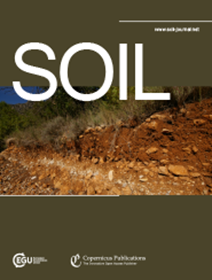A simple model of the turnover of organic carbon in a soil profile: model test, parameter identification and sensitivity
IF 4.3
2区 农林科学
Q1 SOIL SCIENCE
引用次数: 0
Abstract
Abstract. Simulation models are potentially useful tools to test our understanding of the processes involved in the turnover of soil organic carbon (SOC) and to evaluate the role of management practices in maintaining stocks of SOC. We describe here a simple model of SOC turnover at the soil profile scale that accounts for two key processes determining SOC persistence (i.e. microbial energy limitation and physical protection due to soil aggregation). We tested the model and evaluated the identifiability of key parameters using topsoil SOC contents measured in three treatments with contrasting organic matter inputs (i.e. fallow, mineral fertilized and cropped, with and without straw addition) in a long-term field trial. The estimated total input of organic matter (OM) in the treatment with straw added was roughly three times that of the treatment without straw addition, but only 12 % of the additional OM input remained in the soil after 54 years. By taking microbial energy limitation and enhanced physical protection of root residues into account, the model could explain the differences in C persistence among the three treatments, whilst also accurately matching the time-courses of SOC contents using the same set of model parameters. Models that do not explicitly consider microbial energy limitation and physical protection would need to adjust their parameter values (either decomposition rate constants or the retention coefficient) to match this data. We also performed a sensitivity analysis to identify the most influential parameters in the model determining soil profile stocks of OM at steady-state. Input distributions for soil and crop parameters in the model were defined for the agricultural production region in east-central Sweden that includes Uppsala. This analysis showed that model parameters affecting SOC decomposition rates, including the rate constant for microbial-processed SOC and the parameters regulating physical protection and microbial energy limitation, are more sensitive than parameters determining OM inputs. The development of pedotransfer approaches to estimate SOC decomposition rates from soil properties would therefore support predictive applications of the model at larger spatial scales.土壤剖面有机碳周转的简单模型:模型检验、参数辨识及灵敏度
摘要。模拟模型是潜在的有用工具,可以测试我们对土壤有机碳(SOC)周转过程的理解,并评估管理实践在维持SOC储量方面的作用。本文描述了土壤剖面尺度上有机碳周转的一个简单模型,该模型解释了决定有机碳持久性的两个关键过程(即微生物能量限制和土壤聚集引起的物理保护)。我们对该模型进行了测试,并在长期的田间试验中,利用三种不同有机质投入(即休耕、施矿肥和作物、添加和不添加秸秆)处理下测量的表层土壤有机碳含量,评估了关键参数的可识别性。添加秸秆处理的有机质(OM)估计总输入量约为未添加秸秆处理的3倍,但54年后只有12%的额外OM输入留在土壤中。通过考虑微生物能量限制和根残体物理保护的增强,该模型可以解释三种处理间碳持久性的差异,同时也可以使用相同的模型参数准确匹配有机碳含量的时间过程。没有明确考虑微生物能量限制和物理保护的模型需要调整其参数值(分解速率常数或保留系数)以匹配该数据。我们还进行了敏感性分析,以确定在稳态下确定土壤剖面OM储量的模型中最具影响力的参数。模型中土壤和作物参数的输入分布是为瑞典中东部包括乌普萨拉在内的农业生产区定义的。结果表明,影响有机碳分解速率的模型参数,包括微生物处理有机碳的速率常数和调节物理保护和微生物能量限制的参数,比决定OM输入的参数更敏感。因此,通过土壤性质估算有机碳分解速率的土壤转移方法的发展将支持该模型在更大空间尺度上的预测应用。
本文章由计算机程序翻译,如有差异,请以英文原文为准。
求助全文
约1分钟内获得全文
求助全文
来源期刊

Soil
Agricultural and Biological Sciences-Soil Science
CiteScore
10.80
自引率
2.90%
发文量
44
审稿时长
30 weeks
期刊介绍:
SOIL is an international scientific journal dedicated to the publication and discussion of high-quality research in the field of soil system sciences.
SOIL is at the interface between the atmosphere, lithosphere, hydrosphere, and biosphere. SOIL publishes scientific research that contributes to understanding the soil system and its interaction with humans and the entire Earth system. The scope of the journal includes all topics that fall within the study of soil science as a discipline, with an emphasis on studies that integrate soil science with other sciences (hydrology, agronomy, socio-economics, health sciences, atmospheric sciences, etc.).
 求助内容:
求助内容: 应助结果提醒方式:
应助结果提醒方式:


